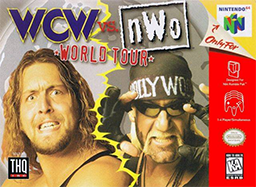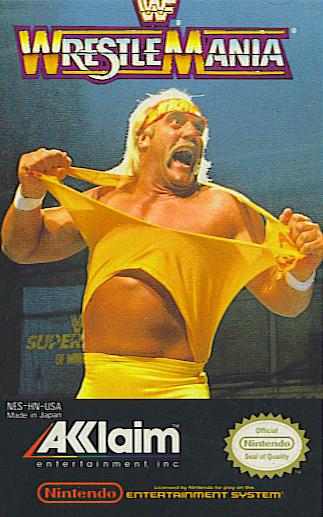February 20th 2013 marked the announcement for video game publisher 2K to make an agreement with World Wrestling Entertainment in response to THQ’s bankruptcy in December 2012. The first game in the new WWE 2K series will drop on October 30, 2013. In the coming weeks most writers are discussing what’s next for wrestling video games, but Culture Crossfire is going to talk about an exciting era in wrestling gaming history, from 1996-2000.
Before this era there were the sprite-based wrestling games, everything from WWF WrestleMania to Fire Pro Wrestling. Japanese developer AKI Corporation released the polygon-based Virtual Pro Wrestling in September 13th, 1996 and was released as WCW vs. the World in the US early 1997. I have personally had very little experience with this game, simply playing it at a friends’ house long after its relevance. Some notable things about the game would be this is the first game to replace the traditional fighting game health bar with a spirit bar, which fluctuates up and down depending on the momentum of the match. Also this was the first game of the Monday Night Wars, which drew interest to everything wrestling.
The Nintendo 64 also launched in September of ’96 but it would be almost a year before a wrestling debut. If I rightly recall, I discovered the 64 at my local Sears back when they had a video game section. I was amazed with Mario 64, what a beautiful game. Being someone who came from a lower-middle class family I didn’t get a Nintendo 64 until 1997. Something else significant happened in ’97 before this, however, my true discovery of professional wrestling. When I think back to my oldest wrestling memory, I believe it was a midgets match. That’s all I remember. I don’t come from a wrestling family, and remain to be the only one with even a passing interest. When I discovered wrestling, I was in 5th grade, prime time for such a hobby, in my opinion. The Monday Night Wars were heating up and I flipped on the TV to TNT out of sheer luck. The New World Order were standing in the middle of the ring and they began to sing O’ Canada very badly, implying that Bret Hart would join the nWo when he arrived. This was the night after the Montreal Screwjob at WWF Survivor Series. This WWF main eventer was jumping ship to WCW and was ensured he wouldn’t leave the company with the WWF Championship. Greater writers have written on this subject and I am only mentioning this so you know the environment as I came into fascination with WCW and WWF. I distinctly remember flipping back and forth from Nitro to RAW every Monday night, and would sometimes watch the Nitro replay after the Monday night movie, but would often fall asleep, as we’re talking 2 AM on a school night. This is the lay of the land when the focus of this article was released.

Developers: Asmik Ace Entertainment, AKI Corporation
Publisher: THQ
Platform: Nintendo 64
Release Date: November 28, 1997
Awesome but eerie Nintendo Power cover
I have no idea how I even found out about this game to be honest. Perhaps a video game or wrestling magazine. Most of my recollection revolves around me receiving the Nintendo 64 itself for Christmas (possibly early?) and renting Mario 64 and Goldeneye 007. At any rate, I got the game for Christmas as well. And then I turned the game on…
That intro is pretty great considering it’s a Nintendo 64 game using the game engine itself instead of pre-rendered graphics that set an incorrect expectation. Might not be as pretty as Final Fantasy 7 or even Super Mario 64, but it sure got me excited at the time. If you notice there’s a smidgeon of voice over in there as well.
As a localized Japanese wrestling (puroresu or puro for short) game, it’s all the fight. There’s no storylines save the built in WCW vs. nWo aspect. Other than the intro there’s no cinematic aspect, which is kind of opposite the actual landscape of American wrestling in 1997. The roster is actually pretty full once you realize the fictitious wrestlers of the two non-WCW/nWo leagues are actually puro stars with fake names for legal purposes. You can have Hollywood Hulk Hogan battle it out with Hayabusa if you desire.
Mechanics and Controls
The game didn’t support in-cartridge saving, which led to me getting a memory card shortly thereafter. There are some big advances between Vs. The World and World Tour. The biggest being the new grapple system. Instead of having to memorize 3-5 button combinations to pull off a simple piledriver, you simply tap or hold the A button and either tap the directional pad up, down, left, or right respectively, and A or B. This works with front, rear and turnbuckle grapple. But what if you wanted to perform an Irish whip? You would simply press the C Down button while grappled. The traditional d-pad controls your movement and the analog stick is used for taunts and building up your fighting spirit meter. When your spirit meter is flashing, perform a strong grapple and toggle the analog stick to pull off your special move. Not all finishers are spot-on for this game, depending on the wrestler in question. Scott Hall comes to mind immediately, myself. His front grapple finisher was a crucifix sit out powerbomb instead of the concussion inducing Outsider’s Edge. My favorite finisher has to be Scott Steiner’s Steiner Screwdriver, which is a vertical suplex into a sit-out tombstone piledriver, and is as awesome as it sounds.
Submission moves would typically be performed by tapping A while your opponent is on the ground. You have four ground grapple moves. One interesting aspect of this is the ability to damage a masked wrestler’s mask by performing a camel clutch on them repeatedly. Chris Jericho must have been proud. This is just a brief overview of the control scheme to put it in perspective, and is not for tutorial purposes. Another great addition is multiplayer. You have up to four wrestlers on screen at once and all four can be player controlled which is pretty huge. That counts for tag team matches or battle royals, respectively. Another notable addition was blood, which was actually out of place at this point in WCW, plenty of blunt force trauma, but not really any bleeding. The exception to that would be 1997 War Games where Curt Hennig shut the cell’s door in Ric Flair’s face repeatedly and violently.
Mean, Median and Modes
So what do you see after you select start once you’re done watching that awesome intro video? You’re treated to the following game modes:
- WCW vs. nWo, a five-wrestler team for head to head elimination matches.
- Exhibition, which houses single matches like 1 vs. 1, 2 vs. 2, Handicap Match and Battle Royal elimination match
- League Challenge, the campaign mode of the game select one of the four leagues and fight gauntlet style to the champion, win and you get the belt.
- League, a round robin tournament awarding points for differing methods of winning. Think the Bound For Glory Series for a contemporary comparison.
- Tournament, eight-man or team tournament, King of the Ring style.
May seem kind of shallow by modern comparison, but this was revolutionary in 1997. All of the matches have editable rules like KO, Submission, etc. There are only four arenas, one for each league, WCW, nWo, DOA and IU (no Bobby Knight doesn’t make an appearance although he would fit in with the chairs and all).
Roster
World Championship Wrestling
- Chris Benoit
- Ric Flair
- Eddie Guerrero
- Lex Luger
- Dean Malenko
- Rick Steiner
- Scott Steiner
- Sting
- Ultimo Dragon
- Rey Mysterio, Jr.
- Steven Regal
- Diamond Dallas Page (Unlockable)
New World Order
- Hollywood Hogan
- Scott Hall
- Kevin Nash
- Syxx
- Eric Bischoff
- nWo Sting
- Buff Bagwell
- Scott Norton
- Macho Man Randy Savage (Unlockable)
Dead or Alive Wrestling
- Sumo Joe (Genichiro Tenryu)
- Kim Chee (Koji Kitano)
- Blackheart (Tarzan Goto)
- Puchteca (Atsushi Onita)
- Hannibal (Hayabusa)
- Powder Keg (Terry “Bamm Bamm” Gordy)
- Dim Sum (Gedo)
- Saladin (Abdullah the Butcher)
- Ali Baba (The Original Sheik)
- Wrath (Unlockable)
Independent Union
- Black Ninja (The Great Sasuke)
- Shaolin (Jinsei “Hakushi” Shinzaki)
- The Unknown (Super Delfin)
- The Claw (Gran Naniwa)
- Black Belt (TAKA Michinoku)
- Paco Loco (Dick Togo & Men’s Teioh)
- Shaman (Wellington Williams Jr.)
- Master Fuji (El Gran Hamada)
- Glacier (Unlockable)
World Wide Wrestling (Unlockable League)
- Joe Bruiser
- Black Widow (Manami Toyota)
Wrap Up
This game and the others to follow came at a perfect time for me. As a ten year old who was lucky to get a couple games a year, this was a great game. There was quite a bit of replayability in the ability to tweak matches. I can still remember when my friends and I realized there were additional Heavyweight and Cruiserweight leagues. We lost it when we unlocked Joe Bruiser and Black Widow. If you had KO enabled in a match, Joe Bruiser would knockout anyone in a matter of minutes. This game supplied me with hours and hours of fun. In my opinion, a puroresu approach to American wrestling was perfect for the technology at the time. This game laid the groundwork for the next three games and a large chunk of my later childhood.




